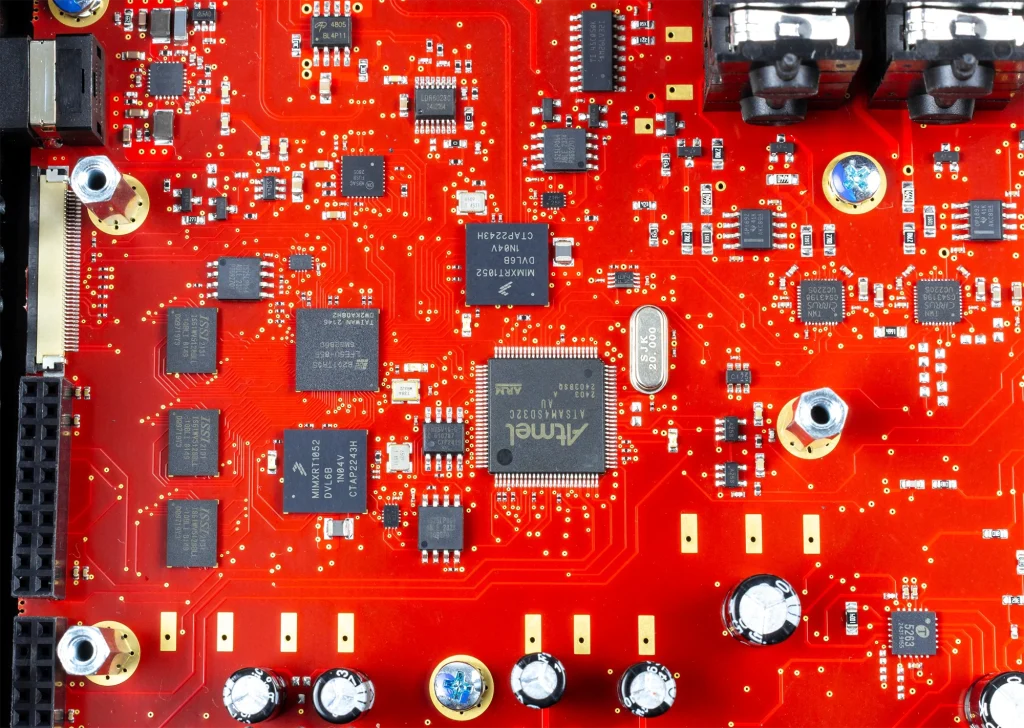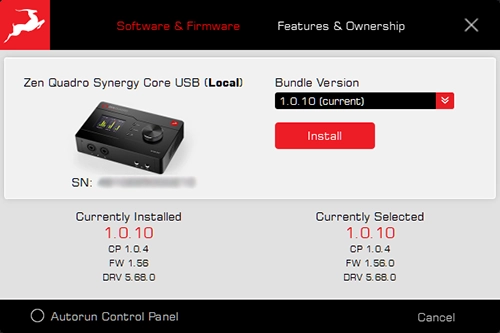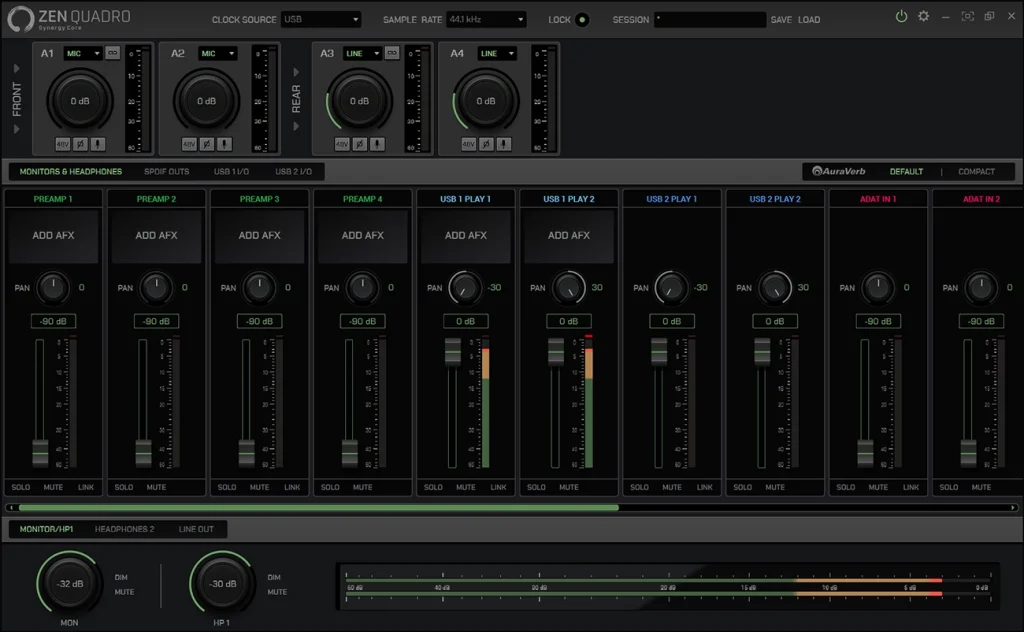Today, we have the Zen Quadro audio interface from Antelope Audio for review, which boasts top-shelf components and a portable form factor, as well as the Synergy Core FX processing. The Antelope Zen Quadro Synergy Core USB audio interface was announced in mid-2024. It replaces the inexpensive Zen Q and Zen Go models. The Quadro boasts two USB connection ports. Why was this done? First, the second port can serve as an additional power supply when connecting iOS and Android devices. Second, it caters to bloggers and streamers who often need to connect two devices at once for internet broadcasting. Compared to its predecessor, the Zen Q, the new Quadro is more appealing because it has four microphone inputs instead of two. The more expensive, professional Antelope Discrete 4 Pro model has Thunderbolt, ADAT, and WordClock connectors. Thus, we can conclude that the Zen Quadro interface is designed for a wider audience that does not require these features.
At a certain point, Antelope's product names began featuring the important prefix "Synergy Core." What does this mean? It refers to Antelope's advanced, proprietary hardware platform, which is based on a combination of ARM processors and FPGAs that model classic analog processing devices. Why was such an unusual synergy needed? The idea is as follows: Rather than creating bulky, expensive racks of equipment, users can simply load hardware plug-ins into the Antelope interface to achieve the same sound. The manufacturer promises that the sound will be as close to the original as possible. FPGAs provide zero latency and parallel processing of multiple channels but have limited computing resources. ARM processors contain FPU hardware blocks and are ideal for implementing complex effects, such as reverb and delay. In addition to powerful processing capabilities, the hardware plugins recreate the appearance of the original devices. This allows professionals to easily navigate the familiar knobs and switches, as well as the beautiful colored peak meters and pointer indicators.
We'll talk about all features a little later in our Antelope Audio Zen Quadro review. As usual, let's first look at the specifications to gain a better understanding of the device.
|
Best Price on Antelope Zen Quadro Interface
The Zen Quadro is a powerhouse—ideal for engineers, musicians, content creators who demand studio-grade conversion, low-latency performance, and DSP-powered processing. |
 Classic Package
Classic Package
|
The specification parameters are very high and comparable to those of more expensive Antelope products.
Now, let's move on to the main part of our review and take a closer look at the Antelope Zen Quadro Synergy Core audio interface's unique features.

The Zen Quadro's body is made entirely of metal. Unlike the Q series, however, it does not have a beveled front. This was a deliberate design choice that allowed us to incorporate guitar inputs, headphone outputs, and microphone inputs via XLR/TRS combo connectors. We would like to comment on the build quality. There is no play or gaps, and the case feels solid, in the best tradition of premium devices. When you hold it in your hands, you immediately sense its high quality.

The rear panel of the Antelope Zen Quadro contains digital and analog inputs and outputs. Power is supplied from the bus. If the laptop connector does not provide enough power, you can connect a separate power supply via a second port, adapter, or power bank. The ADAT connector, which allows you to expand the system by adding eight channels for recording only, is located on the right side.

The color IPS screen allows you to conveniently monitor level indicators and adjust input gain. As with other models, the screen is not very bright, even at 100% brightness. When you turn the knob, the current value of the parameter you are changing is displayed in large digits. The level adjustment step is 1 dB. Presses are clearly registered, and the digital controls are easy to use.
The digital board is representative of the Synergy Core family. It uses FPGA chips and ARM processors for hardware processing.

The line and headphone outputs feature dual-channel CS43198 DACs with specifications of 130dB, SNR: 115dB, and OPA1692 op-amps.
A 4-channel ESS ES9842QPRO ADC with 122dB dynamic range and 116dB SNR is used for digitization.
The headphone outputs are served by a 4-channel TI PCM4104 DAC. Dynamic range: 118dB, SNR: 100dB.
The manufacturer's pride and joy is the discrete preamplifier circuit with 6 transistors in each channel. THAT 5263 digitally controlled dual-channel analog level controls are used for gain adjustment. Gain adjustment is performed in 1dB steps, in the range from 0 to 75dB. This allows any condenser and dynamic microphones, including ribbon microphones, to be successfully connected to the interface without the use of boosters.
The headphone amplifier is based on the JRC4565 op-amp.

Drivers and control panels have evolved significantly in terms of versions, and stability under Windows has improved greatly.

Three mixers enable you to create three distinct submixes, an essential feature for professional work.

The AFX tab allows you to call up effects from the 37 included in the set, and if desired, expand their number on the Antelope website, where sets are sold at a discount. The full list of 37 included plugins includes equalizers, compressors, reverbs, guitar cabinets, and looks like this: VMEQ-5 (3-Band Tube Mid-Range EQ), VEQ-1A (2-Band Tube EQ), VEQ-HLF (Tube 2-Band HPF / LPF), Clear Q (Parametric EQ), VCA160 (VCA Compressor / Limiter), X903 (VCA Compressor / Limiter), Stay-Levin (Vari-Mu Tube Compressor), FET-A76 (FET Compressor / Limiting Amplifier), PowerEX (Expander), PowerGate (Noise Gate), PowerFFC (Feed-Forward Compressor), BA-31 (Germanium Mic Preamp), Gyraf Gyratec IX (Dual Tube Mic Preamp with HPF), Auraverb (Reverb), A-Tuner (Guitar Tuner), 11 x Shred Guitar Amps, 11 x Shred Guitar Cabinets.
In order to use hardware effects in a DAW, you need to install a special afx2daw plugin. This way, even an older computer can be used for creativity because the central processor will be 100% unloaded from processing. Alternatively, you can choose a quiet, miniature NUC computer or a laptop with a modern, quiet processor.
Update on the afx2daw plugin's compatibility with Zen QuadroUnfortunately, afx2daw is not available for Zen Quadro Synergy Core. We learned this from the FAQ page on the Antelope Audio website. One user asked - Is afx2daw available for Zen Quadro Synergy Core? Antelope Audio provided the following response - No - afx2daw is not available for Zen Quadro. To use your real-time FX in the DAW, please refer to this article, showing how to set them up as hardware inserts.
The RTL latency is extremely low! It's only 4.6 ms with a 64-sample buffer and a frequency of 44 kHz. Separately for the output, the latency will be even lower.
We were pleased with the audio interface recording results. The Antelope Zen Quadro produced results comparable to those obtained with the more expensive Discrete 4 Pro. It produced natural, detailed sound corresponding to high-end studio recording standards without coloration or emphasis on frequency ranges. The timbres were transmitted neutrally, which is a prerequisite for the modern processing of material. The line output quality on our ADAM Audio active monitors was also high. The signal was loud enough to feed the soundtrack to the artist through the Beyerdynamic DT 770 PRO headphones.
Finally, we've reached the end of our Antelope Audio Zen Quadro review, it's time to summarize the results. The Zen Quadro is Antelope's most affordable USB audio interface to date and successfully replaces previous junior models. In terms of recording and playback quality, it is in no way inferior to older, more expensive Discrete Pro models—a significant advantage. We liked the sound, as well as the advanced hardware processing in dozens of interesting plug-ins that do not put a load on the CPU. The device costs an impressive $680-$730, which is comparable to that of its direct competitors, such as the RME Babyface Pro FS, the Apogee Duet 3, and the Focusrite Clarett+ 4pre. Compared to these, the Antelope interface looks very competitive, and its two USB inputs will surely appeal to modern users, such as bloggers and streamers.
We hope you enjoyed our review of the Antelope Audio Zen Quadro Synergy Core audio interface. Please feel free to leave your comments, questions, and suggestions in the section below. We will be happy to answer them all as soon as possible. If you already own Zen Quadro and have used it for a while, don't forget to share your impressions and tell us what you liked or disliked about this audio interface.
Pros
|
Cons
|
9.2
/10
Our Score
|